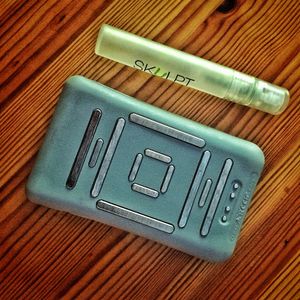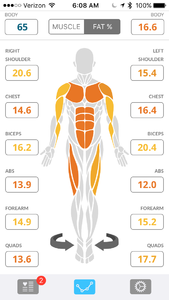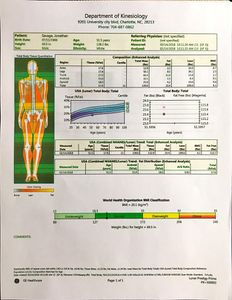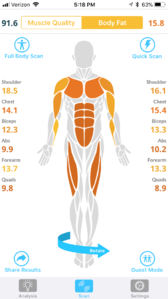Skulpt
Sadly, in 2024, Skulpt has stopped selling their body composition scanner. I've really come to appreciate Skulpt as one of the best measures of body composition. I expect their app will become non-functional at some point, and the device will be effectively bricked.
Skulpt is a small device, a little bigger than a deck of playing cards that estimate body fat and muscle quality. I've found it to be one of the most useful and accurate ways of estimating body fat. It uses a similar principle to Body Fat Scales, sending an imperceptible electrical current through the skin. However, there are a number of key benefits to Skulpt.
- Skulpt compares well with the gold standard for measuring body fat, DEXA, and the results appear to be far better than other approaches. See Validation Research below for details.
- Unlike body fat scales which measure overall body fat through 2 or 4 electrodes on your hands and/or feet, where Skulpt uses 12 electrodes close together to measure body fat over an area of about 2" x 3" (5cm x 8cm).
- Skulpt measures up to 24 specific body locations, and it can estimate overall body fat from three measurements on your triceps, abdominals, and quadriceps.
- One reason for having so many electrodes is to pass a current along and across the muscle fibers. This allows the Skulpt to estimate "muscle quality", something that I thought was nonsense until I reviewed the available research. This muscle quality gives a measurement that can detect muscular imbalances, something that can result in injury.
- If you enable "real time scanning" you can move the sensor around, pausing between readings to find the area with the highest muscle quality that's over the muscle. You mustn't position over the ends of a muscle though, as you could get a higher reading as the muscle merges into the tendon. Ideally, the app would automatically take the reading that has the highest muscle quality as this is the one that's most directly over the muscle and in the correct position, but this hasn't been implemented yet.
- Skulpt doesn't provide any indication of body weight, but by the same token, its estimate of body fat isn't dependent on body weight as an input. This may be one of the reasons Skulpt is as accurate as it is. (I use a Bluetooth scale to give me my weight measurement.)
- Skulpt doesn't use any data about which body part is being measured in its estimate. So, if you measure your quads, it will give the same value even if you tell it you're measuring your triceps. Again, this shows that Skulpt is not tweaking its value based on a muscle specific model or formula.
- If Skulpt has a problem getting a reading, the app shows a warning. This is far, far better than displaying an incorrect value.
There are a few caveats to Skulpt.
- Unlike body fat scales, Skulpt has to have wet electrodes to function, so you have to spray the electrodes with water before testing each area. I replaced the tiny spray that comes with Skulpt for a cheap plant sprayer, which works better and doesn't need refilling as often.
- Body hair can make it harder to get a reading, requiring a little more water, but this doesn't seem to effect accuracy (see research below). I've found that spraying the sensor and applying it, then repeating to get a measurement is easier.
- Unlike scales, where you don't have to worry too much about positioning, Skulpt is quite sensitive to location. Of course, this is because changing the Skulpt position changes how much fat it will be over. Some locations are easier to be consistent than others. For instance, it's easy to be consistent on the abdominals, as the naval can be used as a convenient landmark, where it's far harder on the quadriceps. Real time scanning solves much of this problem (see above.)
- Like any fat measurement, Skulpt is sensitive to hydration. This is simply because hydration will change body fat percentage directly. If you have 10Kg of body fat and weigh 100 Kg, your fat is 10%. Drink 2 Kg of water and you weigh 102 Kg and have a body fat of 9.8%. I've not noticed any of the problems you get with hydration skewing the body fat measurement more than that.
I've been using the Skulpt for about 3 years, and over that time I found it to be quite useful in assessing my body composition. I periodically do a full body scan, but this is too tedious and time-consuming for me to perform frequently. Given the accuracy shown by the research, I've been using "quick scan" of 3 locations to estimate overall body fat. I combine that information with weight from a Bluetooth scale to calculate lean and fat mass (I created a iPhone shortcut to do the calculation.)
Contents
1 Validation Research
Since its release there have been a number of research studies looking at the accuracy of Skulpt, with surprisingly good results. However, these results are on healthy or athletic populations, and there's no research on sedentary or overweight populations.
- A study of 71 young, healthy, and active subjects (38 female) compared Skulpt with DEXA[1]. The study used two Skulpt devices, and measuring three times to see if there are any inter-device variations and inter-repeated measurement variations. The study found no significant differences between DEXA (avg. 23.33%) and Skulpt (23.10%) for total body fat. There was no difference between the two devices, nor between measurements on the subsequent day. (There were significant differences between DEXA and bioimpedance and between DEXA and skinfold thickness.) They noted that body hair slowed down the measurement speed, but didn't change accuracy. The study concluded that these results "should give strong consideration for EIM to be a preferred field method for assessing BF%."
- Comparing Skulpt with DEXA on 69 subjects (33 male) found no significant difference in overall body fat (DEXA avg. 24.44%, Skulpt avg 24.09%), with a mean difference of just 0.35%[2]. The study also compared DEXA and Skulpt body fat measurements of the upper arm and upper leg, measuring left and right sides, as well as trunk. The regional measurements were significantly different, but I suspect the two were not measuring the same thing. For instance, the Skulpt is measuring the body fat of the bicep, where the DEXA is measuring the fat of bicep and triceps, plus the fat between.
- Comparing Skulpt with DEXA with 27 bodybuilders (10 female) found the two had extremely close average readings (15.0 v 15.2)[3]. (The study used bioimpedance spectroscopy as the reference standard, rather than DEXA, making the study results a little harder to interpret.)
- A comparison of 91 participants (50 female) with the BodPod system found a good correlation between the two for body fat (0.904). However, they found a significant difference in the average body fat, with Skulpt reading 27.4% and BodPod reading 21.8%[4]. This study is only available as a "board" rather than a published study, which limits the details. Note that BodPod is not considered a "gold standard" and in some studies the BodPod read lower than DEXA[5], though not by such a large amount.
2 Is Skulpt Worth It?
I think for the price, Skulpt is a worthwhile purchase. I've found its estimate of body fat is credible, allowing me to track changes over time and check if weight loss is from fat or muscle. It's also good to know where the body fat is, thought that's less actionable. The display
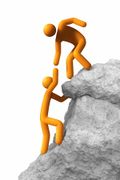
| This review was made possible by readers like you buying products via my links. I buy all the products I review through normal retail channels, which allows me to create unbiased reviews free from the influence of reciprocity, or the need to keep vendors happy. It also ensures I don't get "reviewer specials" that are better than the retail versions.
|
3 Compared with DEXA
I recently had a DEXA scan, and I compared the values with Skulpt. DEXA estimated overall body fat at 17.6% and Skulpt at 15.8%, which is reasonably close. The values for my legs are rather more believable with Skulpt than DEXA. As you'd expect from a runner, I have extremely lean, muscular legs, so the Skulpt estimate of 8-10% seems more credible than the DEXA estimate of 17.8%.
4 Muscle Quality
While the idea of measuring muscle quality seems like pseudo-science, there's quite a bit of research supporting the approach. This technique, known as "Electrical Impedance Myography", was developed for the evaluation of degenerative diseases. I won't attempt to summarize the research, but if you're interested I would recommend doing searching on Google scholar for "Electrical Impedance Myography". There is a 2009 review is a reasonable starting point[6]. The usefulness of muscle quality information is a little harder to evaluate. Not surprisingly, I found my legs had great muscle quality where my arms were rather poor, something that persuaded me to do a little bit of upper body strengthening. So far, I haven't found any correlation between Delayed Onset Muscle Soreness (DOMS) and the indicated muscle quality. I've done enough Treadmill Descent training to reach 2/5 on my DOMS Scale and 3/6 on the Likert Scale Muscle Soreness, and there was no change in the Skulpt Muscle Quality. However, I'm probably close to the top of the range for Muscle Quality in my quads, with absolute values of 145-160 and percentages just under 100%. (I've found no research on Electrical impedance myography and delayed onset muscle soreness.)
4.1 References
- ↑ Cherilyn N. McLester, Alex D. Dewitt, Rasmus Rooks, John R. McLester, An investigation of the accuracy and reliability of body composition assessed with a handheld electrical impedance myography device, European Journal of Sport Science, volume 18, issue 6, 2018, pages 763–771, ISSN 1746-1391, doi 10.1080/17461391.2018.1448458
- ↑ Madeline A. Czeck, Christiana J. Raymond‐Pope, Elyse Prescott, Katie L. Bisch, Donald R. Dengel, Body fat percent assessment between electrical impedance myography and dual X‐ray absorptiometry, American Journal of Human Biology, 2019, ISSN 1042-0533, doi 10.1002/ajhb.23330
- ↑ Austin J. Graybeal, Michael Lane Moore, Megan R. Cruz, Grant M. Tinsley, Body Composition Assessment in Male and Female Bodybuilders, Journal of Strength and Conditioning Research, 2018, pages 1, ISSN 1064-8011, doi 10.1519/JSC.0000000000002831
- ↑ Alyne L. Williams, Melissa Renee Cook, Ciro Moraes Costa De Castro, Annabell Kennell, Victoria Haller, Alex Seabeck, Alex Springer, Correlation Analysis Of The Skulpt© And Bodpod©, Medicine & Science in Sports & Exercise, volume 51, issue Supplement, 2019, pages 935, ISSN 0195-9131, doi 10.1249/01.mss.0000563303.26203.81
- ↑ Dale R. Wagner, Vivian H. Heyward, Ann L. Gibson, Validation of air displacement plethysmography for assessing body composition, Medicine & Science in Sports & Exercise, volume 32, issue 7, 2000, pages 1339–1344, ISSN 0195-9131, doi 10.1097/00005768-200007000-00023
- ↑ Seward B. Rutkove, Electrical impedance myography: Background, current state, and future directions, Muscle & Nerve, volume 40, issue 6, 2009, pages 936–946, ISSN 0148639X, doi 10.1002/mus.21362
- Category:Beginners
- Category:Training
- Category:Nutrition
- Category:Weight
- Category:Ketogenic
- Category:Review
